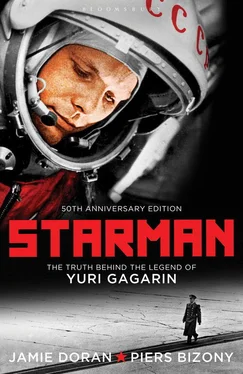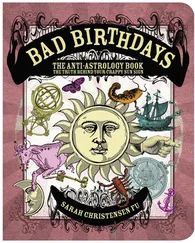The British journalists Wilfred Burchett and Anthony Purdy met Gagarin at the Foreign Correspondents’ Club in Moscow on June 9, and were instantly impressed by his enthusiasm, his firm handshake and confident responses to their questions. They told him they were writing a book about his exploits, and he flattered them by saying that if their determination as authors was anything to go by, ‘The next person in space should be a writer.’
The conversation soon turned to the exploits of NASA. Gagarin made gentle, but pointed, fun of the Mercury project, which had achieved only its first tentative 15-minute sub-orbital hop on May 5, with astronaut Alan Shepard aboard. Burchett and Purdy suggested that the American capsule incorporated more sophisticated attitude (orientation) controllers, thrusters and navigation systems, so that Shepard could genuinely pilot the machine to a greater extent than a cosmonaut could fly a Vostok. This was quite true, but Gagarin evaded the issue by concentrating on the short duration of the Mercury mission. ‘How much driving can you get done in five minutes?’ he challenged. ‘And what would be the point of manual control? I could have guided Vostok, had I wanted to. There was a dual-control, but the manual option was not necessary or important.’ For a pilot this was like saying that his job – his essential skill – was completely irrelevant, but at the time Gagarin could hardly have said anything different. [12] Burchett & Purdy, Cosmonaut Yuri Gagarin , pp. 118–23.
The journalists changed tack and suggested that Mercury’s cabin equipment was better than Vostok’s. Again, this was largely true. Gagarin countered, ‘It’s difficult to compare them. Vostok’s cabin is very big, and the thrust of its engines much greater. We went higher and faster for a much longer time.’
Burchett and Purdy asked him which had been the worst moment during his flight? ‘The re-entry,’ he replied without hesitation – then collected his thoughts for a moment and efficiently covered his tracks. ‘But “worst” is a comparative word. There wasn’t really any particular bad moment. Everything worked, everything was organized properly, nothing went wrong. It was a walk, really.’
Not surprisingly, Burchett and Purdy missed the nuance. Phil Clarke, a modern British expert on Russian space history, suggests that if the story of Vostok’s retro-pack separation failure had leaked out in 1961, it would have caused a sensation, but Gagarin remained consistently skilful at listening to his own answers and guarding against errors.
As always, the most sensitive issue was his method of landing. In the wake of his homecoming celebrations in Moscow, Gagarin was pressed for answers by suspicious foreign journalists. On April 17 the London Times correspondent wrote:
No details have been given about the method of landing. Asked point-blank about this at the crowded press conference, Major Gagarin, more hesitantly than in his other replies, skated over the questions with his answer: ‘Many techniques of landing have been developed in our country. One of them is the parachute technique. In this flight we employed the system where the pilot is in the cabin.’ The pictures published in the press here also give little idea of the spaceship’s structure, but some light was thrown on Major Gagarin’s pride in it when he was seen to wince at the use of the word ‘plane’ at the press conference.
The sports official Ivan Borisenko flew to Paris in July 1961 to negotiate far more searching questions thrown at him by the International Astronautical Federation (IAF) about the altitude record he was claiming on behalf of Vostok. The IAF Director-General asked Borisenko’s delegation outright, ‘Where was the pilot on return, in relation to the space vehicle?’ Borisenko bluffed shamelessly. ‘Ask the Americans if they believe these records for Gagarin were actually achieved! All the people of the world have already endorsed Gagarin’s flight and have accepted it as fact.’ [13] Oberg, Red Star in Orbit , p. 55.
The wrangling went on for several hours, but eventually the IAF caved in without pressing the Soviets for clearer evidence. From now on Borisenko could wave his newly minted IAF certification in front of sceptics as ‘proof’ that Gagarin had landed in his ship and rightfully claimed the altitude record.
On July 11, 1961 Gagarin and his escorts flew to London on a Tupolev-104 Aeroflot airliner. The left-leaning London newspaper the Daily Mirror heralded his arrival with a glowing tribute, accompanied by a bitter critique of the lacklustre official reception. Today the piece can be read as an eerie portent of things to come, as the Conservative government of the time began to collapse under the pressure of 1960s’ modernity:
Gagarin is a brave man, the symbol of one of the greatest scientific feats ever achieved. Yesterday, after two days of stuffed-shirt panic over the correct procedure, the British government at last figured out how they would welcome this world-wide hero. And who are they sending to greet him in the name of the entire British people? Not the Prime Minister, Mr Macmillan. Not the Foreign Secretary, Lord Home. Not even the Minister of Science, Lord Hailsham. Britain’s spokesman on this unique occasion will be an unknown civil servant, Mr Francis Fearon Turnbull, CBE, aged fifty-six. The reason given… is that Gagarin is not a Head of State.
Harold Macmillan did eventually meet Gagarin (though not at the airport) and described him as ‘a delightful fellow’. In fact, Gagarin’s visit to Britain had been sponsored largely by the Foundry Workers’ Union rather than the government, but the ordinary citizens of Britain turned out in force to welcome him. The Times reported that he ‘received a welcome that sometimes bordered on hysteria. Cheering crowds lined the route into London all the way from the airport.’ He arrived by motorcade into the vast Earl’s Court Exhibition Centre in West London to address a crowd of students, then gave a press conference in front of 2,000 journalists from Britain and around the world. Quickly the establishment revised its plans for him. He was summoned to the Admiralty, the Air Ministry and the Royal Society, and finally to Buckingham Palace to meet the Queen. Yaroslav Golovanov, the approved journalist ever in attendance, says that an extra day had to be found in Gagarin’s schedule to make room for this meeting, which raises the fascinating possibility that the royal reception was not planned in advance. Rather, it was a hurried response to circumstances. The Times seemed to confirm this on July 12, with its report that ‘Because of the Palace invitation, Major Gagarin will now return home on Saturday, instead of on Friday as originally planned.’
During an informal luncheon encounter on July 15, the Queen was gracious, particularly when Gagarin ran into the perennial problem of an unversed visitor in the Palace at mealtimes: how to handle the vast array of cutlery. Golovanov recalls the scene. ‘He said, “Your Highness, you know this is the first time I’ve had breakfast with the Queen of Great Britain, and it’s very difficult to know which cutlery to use.” He smiled, and the Queen didn’t hold back. She said, “You know, I was born in this palace, but I still get mixed up.” After that, the meeting went very warmly and sincerely.’
The Queen asked Gagarin all kinds of questions – simple human curiosity breaking through the pomp, as always – and at one point he said tactfully, ‘Maybe you have me mixed up with someone else? I’m sure there are many other pilots like me in your own Royal Air Force.’ In all, the First Cosmonaut was turning out to be an extraordinary asset to Soviet diplomacy, but, as he confessed to Golovanov in a quiet moment, the strain of playing the perfect ambassador was beginning to wear him down. ‘A lot of articles are being written about the flight. Everyone is writing about me, and it makes me uncomfortable because they’re making me out to be some kind of superhero. In fact, like everyone else, I’ve made mistakes. I have weaknesses. They shouldn’t idealize people. It’s embarrassing to be made to seem like such a good, sweet little boy. It’s enough to make one sick.’
Читать дальше












